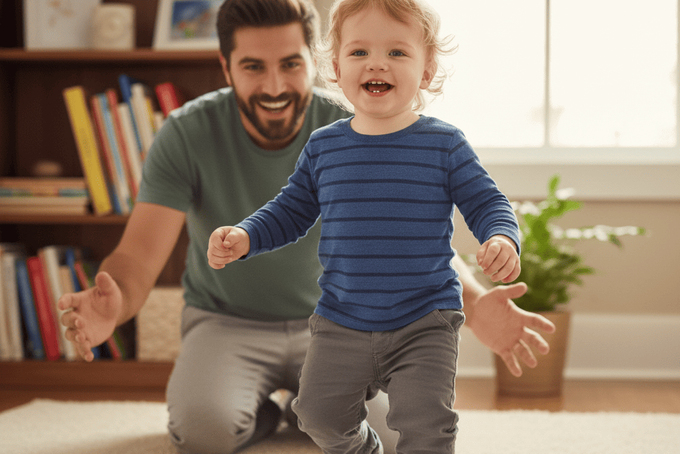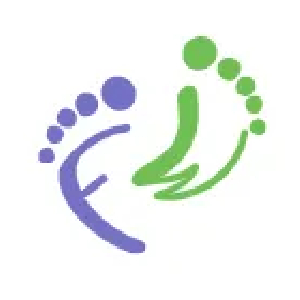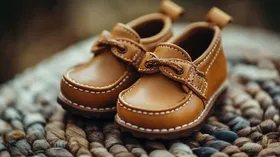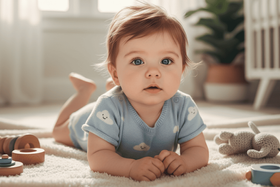What Happens to Toddler Feet in Shoes That Are Too Big?
Shoes that are too big cause immediate problems like falls, blisters, and altered walking patterns in toddlers. Long-term, oversized footwear can lead to flat feet, permanent toe deformities, and chronic pain that may require surgery to correct.
Updated November 4, 2025
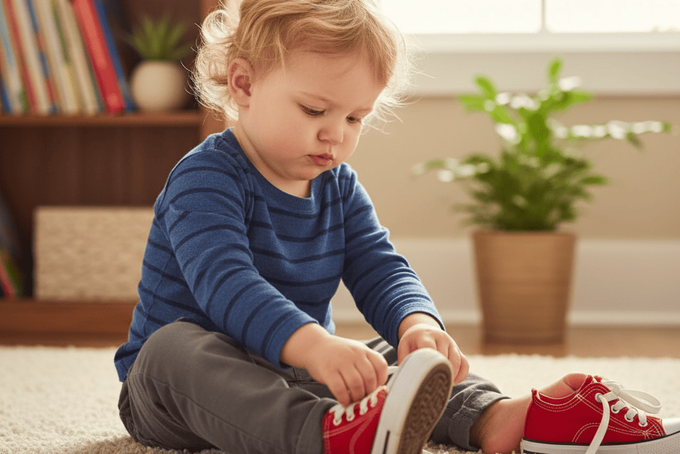
You spot shoes on sale in the next size up and think about buying them now so your toddler can grow into them. Or maybe your child's current shoes still look fine, so you're waiting a bit longer before replacing them, even though they seem loose.
It's tempting to stretch your budget by buying bigger shoes or using ones a bit longer. But those oversized shoes are doing more harm than you realize. What happens if you wear shoes that are too big isn't just uncomfortable; it can actually change how your toddler's feet develop.
Let's look at what's really happening inside those too-big shoes and why proper fit matters more than you think.
Why Parents Buy Shoes Too Big for Toddlers
Most parents buy oversized shoes with good intentions. Kids grow fast, and quality shoes aren't cheap. Buying a size up seems practical and budget-friendly.
Sometimes it's not even intentional. You ordered online without measuring, or your toddler tried shoes on while sitting instead of standing. Maybe they're wearing hand-me-downs from an older sibling, or you're keeping shoes longer because they "still have life left."
Whatever the reason, the question remains: Are there any effects of wearing improperly sized shoes? The answer is yes, and the problems start immediately.
Immediate Problems When Toddlers Wear Shoes That Are Too Big
1. Balance Problems Caused by Wearing Big Shoes
Loose shoes don't move with your toddler's foot. Instead, the foot slides around inside, making every step unstable. Your child can't feel the ground properly through all that extra space, and their brain gets confused feedback about where their foot actually is.
You'll notice:
- Your toddler will stumble more often, especially on uneven surfaces or stairs
- They might walk more carefully or hesitantly than usual
- Some toddlers even start refusing to run or play actively because they don't feel steady
Research shows that wearing shoes that are too big correlates with lower arch height, meaning the foot mechanics are already changing [1]. The foot muscles work overtime trying to keep those shoes in place, creating muscle imbalances that affect the entire leg.
If this continues, those frequent stumbles can lead to actual ankle sprains. The altered foot position puts stress on developing joints. What started as simple instability becomes a pattern your child's body learns and reinforces.
At-Home Support
- Encourage barefoot time on safe, even surfaces to rebuild natural foot strength and balance
- Walking on carpet, grass, or soft ground helps your toddler's feet remember how to move naturally without fighting oversized shoes
2. Altered Walking Patterns and Foot Pain Caused by Big Shoes
Watch a toddler in shoes that are too big. They lift their feet higher than necessary to keep the shoes from falling off. They might shuffle or drag their heels. Some develop an awkward, stomping gait.
This isn't just funny or cute; it's your child's body compensating for poorly fitted footwear. The muscles in their feet, shins, and calves are working in unnatural ways, leading to complaints of tired or achy heels, feet, and legs, especially after active play.
Those compensation patterns become habits. Your toddler's brain learns this inefficient way of walking, and it becomes their normal. Over time, it becomes obvious that wearing shoes too big is an issue as muscle imbalances develop throughout the legs.
The altered mechanics affect more than just walking. You'll notice:
- Running becomes difficult
- Climbing playground equipment feels harder
- Your active toddler might start avoiding physical play because movement doesn't feel right anymore
At-Home Support
- Practice normal walking on soft, even surfaces like carpet or grass
- Simple balance exercises like standing on one foot and walking heel-to-toe can help retrain proper movement patterns. Always supervise until coordination improves
3. Blisters and Skin Irritation Caused by Wearing Big Shoes
In oversized shoes, your toddler's foot slides back and forth with every step. This constant friction creates heat and rubbing against the heel, sides, and toes.
You'll find:
- Red marks when you remove their shoes at the end of the day
- Small blisters forming on the feet, heels, or between toes
- Some areas develop calluses from repeated rubbing
- Your toddler might complain when putting on shoes or start walking strangely to avoid the sore spots
Those blisters aren't just uncomfortable; they change how your child walks. To avoid the pain, they shift weight differently, creating the same gait alterations we discussed above. Now you have both mechanical problems and pain-driven compensation happening together.
If blisters break, they create open wounds on tiny feet that are still developing. These can become infected, especially in active toddlers who sweat in their shoes and play in less-than-sterile environments.
At-Home Support
- Check your toddler's feet daily for any red marks or developing blisters
- Clean and protect problem areas immediately
- Well-fitting socks provide a barrier between skin and shoe, reducing friction while you transition to properly fitted footwear
Long-Term Damage From Wearing Shoes That Are Too Big
1. Flat Feet Development Caused by Wearing Big Shoes
Toddler feet are naturally flexible with developing arches. Those arches form gradually as bones mature and muscles strengthen. But this process requires proper support and natural foot mechanics.
Oversized shoes interfere with natural arch formation. Research shows that incorrect footwear can permanently alter foot structure during these critical development years [2]. The medial arch collapses because the foot lacks stable positioning inside the shoe.
You might notice:
- Your toddler's feet look flatter than before
- The shoes wear unevenly, with excessive wear on the inner edges
- Your child's heel might lift on the outer side when standing
- Your little one's complaints of foot fatigue become common, even after moderate activity
It's bad to wear shoes that are too big when arches are forming. If flexible flat feet aren't addressed early, they can progress to rigid flat feet, a permanent structural change that cannot be reversed without surgery.
As the condition progresses, your child experiences increasing foot and leg pain. Walking and running become uncomfortable. The altered foot mechanics affect knees, hips, and even the lower back as the body tries to compensate for the foundation problems.
How a Professional Can Help
A podiatrist assesses the degree of arch collapse and prescribes custom orthotics or specialized footwear with proper medial arch support and heel correction.
Expert Note: Physical therapy strengthens foot muscles and prevents further deterioration. Early intervention is important because waiting makes flat feet correction much more difficult.
2. Chronic Instability and Balance Difficulties Caused by Wearing Big Shoes
Oversized shoes change your toddler's biomechanics from the ground up. The unstable base affects how bones grow and develop. Stress distributes unevenly across joints, impacting the entire kinetic chain from foot to spine.
These altered mechanics affect proprioception—your child's sense of body position and movement. Balance becomes more difficult. The muscle length-tension relationships change, increasing the risk of strains and sprains throughout the legs.
You'll notice:
- Frequent falls even as your child gets older
- Complaints of shin pain become regular
- Your child mentions muscle aches in their legs and lower back after playing
- They might avoid activities that require good balance or quick direction changes
Over time, your child's body learns these compensatory, abnormal gait patterns. What started as an adaptation to oversized shoes becomes their permanent walking mechanics. Research confirms that footwear fit directly impacts developmental milestones and movement quality in toddlers [3].
The progression affects more than just feet. Knee pain develops from altered load distribution. Back pain emerges as the spine compensates for foundation instability. Your child's entire musculoskeletal system adapts to improper foot mechanics established during critical growth years.
How a Professional Can Help
Physical therapy focusing on gait training, balance exercises, and muscle strengthening helps retrain proper movement patterns. A podiatrist consultation ensures your child will be wearing the correct, adaptive footwear going forward.
Expert Note: Running and movement mechanics need professional assessment and correction before patterns become permanent.
3. Permanent Toe Deformities Caused by Wearing Big Shoes
Long-term flat feet and altered foot mechanics can progress to structural toe deformities. Hammer toes, hallux valgus (bunions), and claw toes all stem from prolonged improper foot positioning and mechanics [4].
These deformities start subtly. You might notice:
- Your child's toes looking slightly bent or positioned differently than before
- Calluses form around the forefoot from abnormal pressure points
- Redness and skin irritation appear frequently around the toe joints
As deformities progress, they become rigid rather than flexible. The toe joints lock in abnormal positions. Your child will experience increasing pain when walking or wearing shoes. What happens when your toddler wears shoes that are too big during the development years can become permanent structural damage.
At advanced stages, conservative can treatments fail. The bones and joints will have adapted to abnormal positions for so long that they cannot return to normal alignment without surgical intervention.
How a Professional Can Help
Early stages require podiatrist guidance for properly fitted shoes, toe spacers, and night splints that encourage proper positioning. Physical therapy works on restoring muscle balance and strengthening intrinsic foot muscles.
Expert Note: If deformities become rigid and permanent, surgical correction will become the only option to restore function.
How Much Bigger Should I Buy My Child's Shoes
The right answer to how big your childs shoes should be is about a thumb-width (approximately 0.5-1cm) of space beyond the longest toe when your child is standing.
This small amount allows for natural foot movement and minor growth without creating the instability and problems we've discussed. Like this, there's enough room for healthy development, but not so much that the shoe doesn't function properly.
Also, check fit every 2-3 months during rapid growth periods. Toddler feet can grow a half-size every three to four months, making regular assessment essential.
When trying on shoes, have your child stand rather than sit. Their foot spreads and lengthens under weight-bearing, giving you accurate fit information on what the maximum children shoes size they can wear. Check that the heel doesn't slip when walking and that the widest part of the foot aligns with the widest part of the shoe.
Can Thicker Socks Make Oversized Shoes Safer?
Some parents ask if thicker socks can compensate for shoes that are too big. While thick socks provide a slightly better grip than thin ones in loose shoes, this is not a real solution.
The problem remains: the shoe doesn't fit properly. Thick socks might reduce some sliding, but they don't address the altered biomechanics, unstable base, or improper foot positioning that oversized shoes create.
Socks are a temporary band-aid, not a fix. Your toddler still experiences the balance problems, gait alterations, and developmental risks we've discussed. Proper footwear fitting and assessment remain essential regardless of sock thickness.
The "Balance Training" Myth About Oversized Shoes
Some people claim oversized shoes provide balance training by creating an unstable surface. This is completely false and potentially harmful.
Incorrect shoes don't promote balance training, they promote compensatory strategies. Your toddler's body learns to fire different muscle groups in unnatural patterns, worsening symptoms rather than building skills.
Real balance training requires stable, properly fitted footwear or controlled barefoot activities. Altered biomechanics from oversized shoes interfere with the ankle and hip strategies needed for true balance development. You're not training balance, you're teaching poor movement patterns that become increasingly difficult to correct.
What About Toddlers Wearing Shoes That Are Too Tight?
While we've focused on oversized shoes, wearing small shoes cause serious problems too. Foot pain, redness, and abrasions appear quickly. Circulation can be affected, and in severe cases, neural involvement causes numbness.
Tight shoes force toes to curl unnaturally, making walking and running painful. Like oversized shoes, tight footwear affects bone growth and alters gait mechanics, leading to long-term musculoskeletal problems [5].
The message is clear: both too-tight and too-loose shoes harm developing feet. Proper fit isn't optional—it's essential for healthy development.
Getting the Fit Right for Your Little One
Oversized shoes harm your toddler's developing feet, from immediate balance problems and blisters to long-term flat feet and permanent deformities. Those "room to grow" shoes aren't saving money; they're risking your child's foot health and potentially costing you in medical bills and therapy appointments down the road.
Proper fit isn't negotiable during these critical growth years. And, you can support your little one's feet with First Walkers shoes that are designed with precise sizing that accommodates natural growth without compromising support.
Remember to check fit every 2-3 months and replace shoes when needed. Your toddler's feet are building the foundation for a lifetime of healthy movement.
References
Puszczalowska-Lizis, E., Lizis, S., Prusak, M., & Omorczyk, J. (2022). Impact of length and width of footwear on foot structure of preschool-aged children. PeerJ, 10, e13403. https://doi.org/10.7717/peerj.13403
Okai-Nobrega, L. A., & Teles Santos, T. R. (n.d.). The Influence of the Shoe over the Medial Foot Arch and the Lower Limbs Kinematics in Toddlers. Scielo. https://www.scielo.br/j/rbort/a/WKC4SbJqzQm7YPXSfwKb5sm/?lang=en
Takaki, K., Kusumoto, Y., & Takahashi, E. (2025). Associations between footwear fit and developmental milestones in toddlers: a cross-sectional study. Journal of Physical Therapy Science, 37(7), 336–340. https://doi.org/10.1589/jpts.37.336
Ryan, M. &. S., & Ryan, M. &. S. (2025, June 17). Flat feet and foot deformities: How flat arches can lead to bunions, hammertoes, and more - Foot Focus Podiatry. Foot Focus Podiatry -. https://footfocus.ie/flat-feet-and-foot-deformities-how-flat-arches-can-lead-to-bunions-hammertoes-and-more/
Tight shoes and foot problems - OrthoInfo - AAOS. (n.d.). https://orthoinfo.aaos.org/en/diseases--conditions/tight-shoes-and-foot-problems/
Disclaimer: First Walkers' information is intended for educational and informational purposes related to toddler footwear and feet. We encourage you to consider individual circumstances and consult qualified orthopaedists about specific conditions.
FAQs
How much room should be in toddler shoes?
About a thumb-width (0.5-1cm) of space beyond the longest toe when standing. This allows natural movement and minor growth without creating instability or the problems associated with shoes that are too big.
Can wearing big shoes cause flat feet?
Yes. Oversized shoes interfere with natural arch formation during critical development years. The unstable positioning prevents proper muscle engagement, and research shows incorrect footwear can permanently alter foot structure, potentially leading to flat feet.
How often should I check my toddler's shoe fit?
Every 2-3 months during rapid growth periods. Toddler feet can grow a half-size every three to four months, making regular assessment essential to avoid both too-tight and too-loose shoes.
Will my toddler's altered walking pattern from big shoes go away?
It depends on how long they've worn oversized shoes. Short-term use can be corrected with proper footwear and barefoot strengthening activities. Long-term use may require physical therapy to retrain proper gait patterns that have become habitual.

